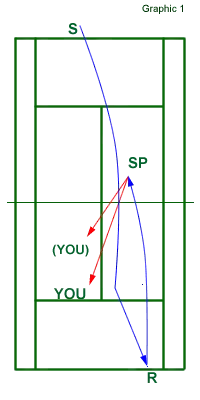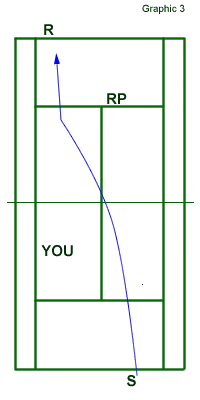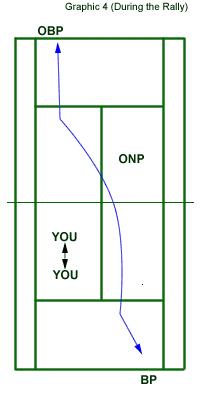Ideally when playing at the net, in doubles (and singles), the closer you stand to it, the better. But considering that you will leave too much open court behind you (susceptible to lobs), standing very close to the net must be evaluated…
When your partner is about to return serve you should stand on the service line (your side) for the following reasons:
1. If your partner’s return is intercepted by the opposing net player you will be in a better position to defend considering the bigger distance from him which will give you more time to react to his eventual attack.
In contrast, standing close to the net (let’s say: about halfway between the service line and the net) will give you very little time to react to your net opponent’s poach directed at you (see graphic 1 below).

2. By standing at the service line, when your net opponent poaches he will not have the big opening to go for a winner between you and your partner. In fact, there is barely any room for him to hit a put-away unless he aims for wide-angle shots which means he’ll have to be very close to the net to do so (see graphic 2 below).

In conclusion, when your partner receives serve, you should stand at the service line until his return has successfully passed the opposing net player and ONLY THEN you should move up to the net following the direction of the ball:
– if the return was made wide towards the alley then you move towards the same side alley too (to cover the potential down-the-line passing shot).
– if the return has been sent closer to the center line then you should move forward and a little to the center too – be ready to poach.
In this situation position yourself about halfway inside the service court (see graphic 3 below). If you are a bit fearful of being hit by your partner’s serve it is ok to move a little off toward the sideline.
The reason you want to be closer to the net is that as soon as your partner’s serve is delivered in, you should be the first to attempt intercepting the return.
By being closer to the net you’ll have better chances for a high volley. If you’d be further back (e.g. closer to the service line) you would expose yourself to low balls sent at your feet – which are hard to handle resulting in easy put-away opportunities for your opponents.

Tip:
As soon as you see your partner’s serve going in, move closer to the net and in the direction of the ball bounce: if it lands close to the center line then move closer to the center too; if it lands close to the sideline then step wide to cover the alley.
You will have better chances to poach when your partner’s serve is closer to the center line or into the body; so make a mental note to jump on the ball when you notice these two types of serves happening.
As the rally takes place between the back players (if playing in the one-up-one-back formation) you should consider the following actions in order to help your partner and be in a position to poach or hinder your opponents’ attacks:
1. As the ball is being handled by your back partner you should move at least one step back. By doing this you will open the court for your partner to hit a cross-court (if he chooses to hit away from the opposing net player). Besides, by moving back, if your net opponent poaches you will have more time to react to his shot. (as mentioned above)
2. When the ball sent by your back partner passes you and it goes to the opposing back player, you should quickly move forward which gives you a better chance to close the angles and poach (see graphic 4 below).

Where you position yourself at the net will make a huge difference in whether you will just be some player at the net or you’ll be a tough opponent who is a distraction and an impediment for the opposing team.
Good court positioning comes with quick movement so be ready to get active at the net. Your partner will thank you. :)